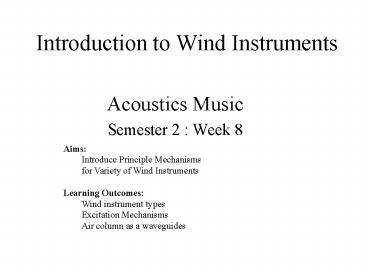Introduction to Wind Instruments PowerPoint PPT Presentation
1 / 14
Title: Introduction to Wind Instruments
1
Introduction to Wind Instruments
- Acoustics Music
- Semester 2 Week 8
Aims Introduce Principle Mechanisms for
Variety of Wind Instruments Learning
Outcomes Wind instrument types Excitation
Mechanisms Air column as a waveguides
2
Principle Components
- Excitation Source (lips and mouthpiece/reed)
- Main oscillator/waveguide (column of air)
- Resonator (body, horn, bell, etc)
3
Brass Instruments
- Excited by air flow of through a player's lips
- Lips / Breath
- pressure-controlled valve
- (embouchure) - determines impedance at the
mouthpiece and hence the boundary condition for
oscillation - excites resonance's similar to harmonic series
0.7f, 2f, 3f,.. - though with pedal note
- Valves control the effective length hence
together with changes in embouchure musical
scales can be constructed - Bell
- efficient radiator of acoustic energy providing a
gradual transition from high tube impedance to
lower outside air impedance - reflects low frequencies back to the mouthpiece
hence filter - reflected energy gives positive feedback to the
player. - conical shape determines modal response
4
Woodwind Instruments
- single-reed driven instruments (clarinets and
saxophones) - double-reed instruments (oboes, bassoons,
english-horns) - air-reed instruments (flutes, piccolos, and
recorders)
5
- The reed functions as a pressure-controlled valve
- With single reed player's lips can control input
impedance - Toneholes to vary the effective length of the air
column - A tonehole lattice acts as a high pass filter,
reflecting back low frequency components and so
influencing timbre. - A register hole (vent) destructively interferes
with the fundamental resonance of the air column
so forcing oscillations at the next strongest
resonance. - Horn or bell radiates, resonates, filters and
provides positive feedback
6
Air reed
lower pressure at top sucks air upwards, hence
leaves rarefaction that sucks air back
- Flutes
Crumhorn / Modern Sax
Shawn / Modern Oboe
7
Cornet
Early cornets used tone holes
Modern version gives a complex array of tubing
8
How do we build a scale on a wind instrument?
Consider wave number
Intervals on trumpet, trombone, etc see
tutorial notes
9
Wave Equation for Pipe
pressure change
cross-sectional area
- Assumptions
- Friction negligible
- Thermal conductivity negligible
- Ignore Gravity
- Pipe is sufficiently narrow for displacement to
be the same for all points across it's width.
10
Pressure in and out of small section
Fma
Where e is particle displacement (particle is
small volume molecules continuous i.e. density,
temp and pressure effectively constant)
11
Consider pressure changes that are too fast for
energy go in and out of system (e.g. acoustic
pressure)
- Adiabatic expansion
P0 atmospheric pressure, V0 volume, ? Adiabatic
gas constant, K constant
So small changes with respect to volume, given by
Substituting for K
Can consider this small change in pressure as
acoustics pressure
12
Acoustics Pressure
adiabatic gas constant
atmospheric pressure
Differentiating equation of motion
Substitute
Wave Equation for Pipe
13
Solution
- The general harmonic solution for this general
type of equation is - or
- Which suggest two waves moving backwards and
forwards along the pipe in opposite directions
and stationary modes.
14
Application of boundary conditions
Assume high impedance at mouthpiece
Closed/Closed Pipe
1f, 2f, 3f, 4f,
1f, 3f, 5f, 7f,..
Closed/Open Pipe
Realistic
0.7f, 2f, 3f, 4f, 5f

